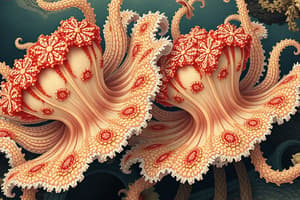Podcast
Questions and Answers
What is a defining characteristic of sponges?
What is a defining characteristic of sponges?
- Special cells called choanocytes
- Radial symmetry
- Gastric cavity with a single opening
- Simple organization (correct)
Which sub-branch of Coelenterates is characterized by hermaphroditic organisms?
Which sub-branch of Coelenterates is characterized by hermaphroditic organisms?
- Nematoblasts
- Ctenaria (correct)
- Cnidaria
- Hydra
What is the main mode of water exchange in sponges?
What is the main mode of water exchange in sponges?
- Peduncle
- Cavities, canals, and holes (correct)
- Tentacles
- Gastric cavity
Which class does the freshwater hydra belong to?
Which class does the freshwater hydra belong to?
What is the function of special cells called colloblasts in Ctenaria?
What is the function of special cells called colloblasts in Ctenaria?
What is the substance that bonds the two layers of the hydra's body together?
What is the substance that bonds the two layers of the hydra's body together?
How does the hydra catch and paralyze its prey?
How does the hydra catch and paralyze its prey?
Which part of Taenia saginata attaches to the human intestine?
Which part of Taenia saginata attaches to the human intestine?
What is contained in each ring of Taenia saginata?
What is contained in each ring of Taenia saginata?
What is the developmental stage of Taenia saginata that is swallowed by the intermediate host (bovine)?
What is the developmental stage of Taenia saginata that is swallowed by the intermediate host (bovine)?
Which of the following is true about Annelids?
Which of the following is true about Annelids?
What is the distinguishing feature of Hirudinea among the Annelids?
What is the distinguishing feature of Hirudinea among the Annelids?
Which statement is true about the leech's anatomy?
Which statement is true about the leech's anatomy?
What is the primary mode of respiration in Annelids?
What is the primary mode of respiration in Annelids?
What distinguishes the circulatory system of Annelids from that of Nematodes (roundworms)?
What distinguishes the circulatory system of Annelids from that of Nematodes (roundworms)?
What distinguishes Oligochaetes from Polychaetes among Annelids?
What distinguishes Oligochaetes from Polychaetes among Annelids?
What distinguishes Nemathelminthes (roundworms) from Annelids in terms of body covering?
What distinguishes Nemathelminthes (roundworms) from Annelids in terms of body covering?
Which statement is true about Ascaris, a parasite of the human intestine?
Which statement is true about Ascaris, a parasite of the human intestine?
Which feature distinguishes Annelids from Nemathelminthes in terms of reproduction?
Which feature distinguishes Annelids from Nemathelminthes in terms of reproduction?
Flashcards are hidden until you start studying
Study Notes
Sponges and Coelenterates
- Sponges are characterized by a porous body and lack of true tissues and organs.
- The subclass of Coelenterates known for hermaphroditic organisms is Hydrozoa.
- Water exchange in sponges primarily occurs through a system of canals and pores, facilitating filtration feeding.
Hydra and Ctenaria
- Freshwater hydra belongs to the class Hydrozoa within Coelenterates.
- Colloblasts, special cells in Ctenaria, function to capture and immobilize prey using a sticky secretion.
Taenia Saginata
- The scolex is the part of Taenia saginata that attaches to the human intestine.
- Each proglottid, or segment, of Taenia saginata contains reproductive organs and gametes.
- The larval stage of Taenia saginata consumed by the intermediate host (bovine) is the cysticerus.
Annelids and Their Features
- Annelids are segmented worms that exhibit true coelom and a segmented body plan.
- In the class Hirudinea (leeches), the distinguishing feature is the absence of setae (bristles) and the presence of suckers.
- Leeches possess a flattened body structure and do not have a clitellum except during reproduction.
- Respiration in Annelids primarily occurs through their skin via diffusion.
Circulatory and Reproductive Differences
- Annelids have a closed circulatory system, whereas Nematodes have an open circulatory system without blood vessels.
- Oligochaetes are distinguished from Polychaetes based on the presence of setae, with Oligochaetes having fewer and simpler setae.
- Nemathelminthes, or roundworms, have a tough cuticle covering their bodies, distinguishing them from the softer, segmented bodies of Annelids.
- Ascaris, a human intestinal parasite, is noted for its habit of living within the intestinal tract and systemic reproduction via eggs expelled in feces.
Reproductive Traits
- A significant reproductive feature distinguishing Annelids from Nemathelminthes is that Annelids exhibit sexual reproduction with distinct male and female forms, while many Nematodes are often dioecious.
Studying That Suits You
Use AI to generate personalized quizzes and flashcards to suit your learning preferences.




